Exploring Veil and Hijab: Cultural and Fashion Perspectives
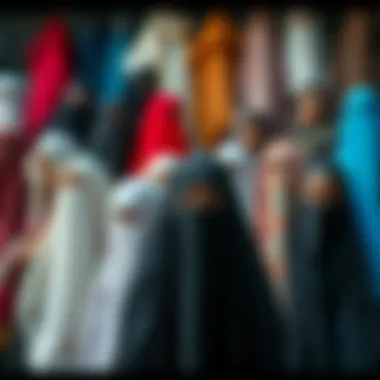

Intro
The veil and hijab hold a significant place in cultures around the globe, encapsulating a rich tapestry of history, beliefs, and fashion endeavors. These garments are often viewed through multiple lenses—be it religious, cultural, or fashion-related. For neophytes and enthusiasts alike, understanding the veil and hijab means traversing through complex narratives steeped in identity and personal choice. In a world where the conversation surrounding modesty and fashion is evolving, it's vital to uncover not just the aesthetic importance but also the deeper connections these garments foster among women.
Through this exploration, we aim to take a closer look at how the veil and hijab have transitioned from mere symbols of culture to powerful statements within the modern fashion industry. As we peel back the layers, we will also showcase the trends and practices that have emerged, illustrating how tradition meets contemporary style.
So often, these garments are mistakenly pinned down to singular interpretations. Yet, they embody a rich spectrum of thoughts and feelings, reflecting the desires and agency of the women who choose to wear them. This article will not only shed light on ongoing discussions within the fashion space but also highlight the underlying significance of choice and representation in the realm of modest fashion.
Join us as we embark on this multifaceted journey to dissect the cultural and fashion dynamics of the veil and hijab, giving you context and insight into why they continue to inspire and provoke thought in today’s society.
Understanding the Veil
The veil carries a weight of significance that goes beyond mere fabric. In many cultures, it is a tangible connection to heritage and identity, shaping how individuals perceive themselves and are perceived by others. Understanding the veil is crucial because it touches on dimensions of feminism, personal choice, and cultural expression. These garments serve not only as accessories but also as essential elements in cultural dialogue, reflecting beliefs, values, and the complexities of gender roles.
Historical Context
Delving into the historical context of the veil, one uncovers layers of meaning that have evolved over centuries. Initially, veils were predominantly protective garments meant to shield women from the harshness of the elements or the watchful gazes of society. Over time, though, they transformed into symbols of status, modesty, and sometimes, even oppression. This history isn't linear; rather, it varies significantly across regions and communities, making it essential to grasp its diverse interpretations in today’s world.
Types of Veils Worldwide
Types in Middle Eastern Culture
In Middle Eastern culture, veils like the niqab and burqa are perhaps the most recognized worldwide. They often connotate adherence to Islamic principles and signify a commitment to modesty. One key characteristic of these veils is their ability to blend functionality with cultural expression. Women wear them for various reasons, including religious observance and personal choice. However, the unique feature of the niqab, which covers the face while leaving the eyes visible, can also spark discussions about autonomy and visibility in society. This duality poses both advantages, in that it allows women a level of privacy in public spaces, and disadvantages, as it sometimes leads to misinterpretation of intentions or identity.
Diverse Practices in South Asia
Turning to South Asia, one finds an eclectic mix of practices surrounding veiling, including the chadar or dupatta—light shawls that many women drape over their heads. The diversity of choice here highlights a tapestry of cultures and religions. Women might prefer these options for their cultural significance or comfort. A distinctive characteristic that stands out is flexibility; these garments can be styled in numerous ways, adapting to both traditional ceremonies and contemporary settings. However, such adaptability can occasionally blur the line between cultural homage and fashion statement, making it a topic ripe for exploration in understanding cultural identity.
Veiling Traditions in North Africa
In North Africa, the haik and melhfa serve as popular forms of veiling. These garments often signify regional pride and cultural traditions specific to communities. One of their key characteristics is the way they often incorporate local patterns and colors, giving these veils a unique aesthetic appeal. While they serve similar purposes of modesty and identity, their distinct regional characteristics make them notable for discussions about cultural appropriation versus appreciation. The advantage of wearing these veils is that they often empower women to reclaim their heritage in global discussions.
Cultural Significance
Symbolism in Various Cultures
The veil symbolizes vastly different things across cultures. While in some contexts it represents piety and respectability, in others, it becomes a canvas of rebellion against societal norms. Understanding these varied symbolisms is beneficial for discerning the cultural narratives surrounding the veil. A unique feature of this symbolism is its fluidity; it can symbolize liberation or constraint, depending on the beholder's perspective. However, the disadvantage lies in the misinterpretation of these symbols, which can lead to oversimplified views in global conversations.
Impact on Gender Roles
The impact of the veil on gender roles is a significant area of exploration. Often, it’s perceived as a tool either reinforcing traditional gender roles or challenging them. A key observation here is that women who choose to wear the veil often navigate complex intersections of identity and societal expectation. This adaptation can symbolize empowerment but may also inadvertently cement existing gender norms. The unique aspect of this dynamic is that it illustrates the ongoing negotiations of gender within various cultural contexts.
Veil as a Marker of Identity
Lastly, the veil acts as a potent marker of identity. Women may wear veils to signal belonging to certain communities or as a personal declaration of faith. This characteristic ties deep into one’s sense of self and illustrates the role of garments in self-expression. However, it can also present challenges, especially in multicultural environments where such identifiers might attract stereotypes. Navigating these challenges often requires thoughtful engagement with both personal beliefs and cultural histories.
The Hijab: A Complex Identity
The hijab remains a nuanced symbol, embodying diverse meanings across cultures and contexts. It's more than just a piece of cloth; it allows for a complex interplay of identity, cultural heritage, and personal choice. Individuals who wear the hijab find it to be both an expression of faith and a personal statement about their beliefs. However, the hijab does not exist in a vacuum. It captures discussions surrounding feminism, autonomy, and challenges faced by women in society. Keeping this in mind helps us understand not just the hijab itself, but the cultural landscape it inhabits.
Defining the Hijab
The hijab has varying definitions and interpretations, often influenced by cultural contexts. At its core, the hijab generally describes a headscarf that covers the hair, neck, and sometimes shoulders, while leaving the face clear. Yet, styles and variations occur depending on preferences and social environments.
Different Styles and Variations
The array of hijab styles reflects a rich tapestry of cultural backgrounds. For instance, the shahada is a simple scarf draped around the head, while the chador is more enveloping, often used in Iran. Each style carries its own significance and resonates with different identity narratives.
One key characteristic of these styles is their adaptability. Women can choose a hijab style that suits their personal taste, occasion, or cultural setting. This versatility makes the hijab a popular choice among many. However, ease of use baring its own challenges: some styles may require intricate tying or adjustments, taking extra time and effort.
Material and Fabric Choices
When it comes to wearing a hijab, choosing the right material is critical. Various fabrics like cotton, chiffon, and silk can be used, each having its own seasonality and comfort levels. For instance, cotton is breathable and ideal for warm weather, whereas silk offers a more formal appearance.
The key characteristic of this aspect is comfort. The fabric can greatly influence how one feels throughout the day, especially given that some women may wear the hijab for extended periods. However, synthetic materials, while often affordable, may lack breathability, leading to discomfort over time.
Theological Underpinnings
To fully grasp the complexity of the hijab, one must consider its theological background. Different interpretations exist within Islamic teachings, influencing how the hijab is perceived across various communities.
Interpretations of Modesty
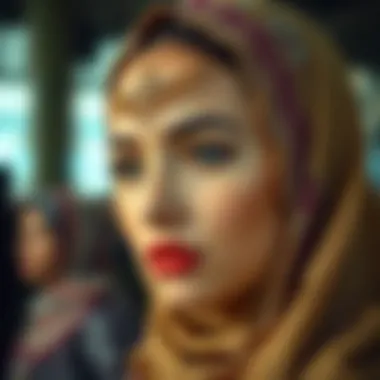
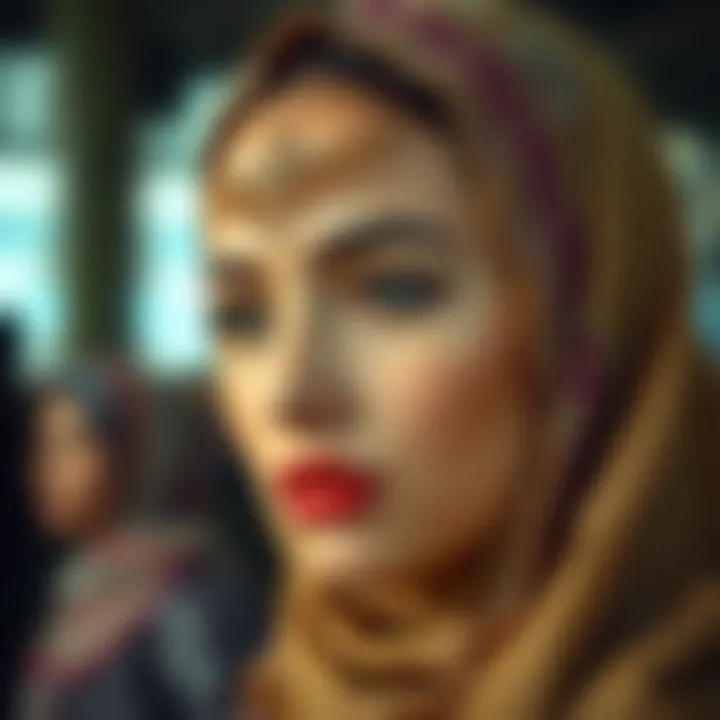
The notion of modesty transcends mere clothing; it encompasses attitudes and behaviors. Within many interpretations, modesty serves as a pathway to fostering respect, both for oneself and for others. The key characteristic here lies in the understanding that modesty is not solely visual—it also incorporates one's actions and demeanor.
This concept is beneficial in shaping self-perception and community interactions, but it also opens discussions on the extremes. Some argue for an interpretation of modesty that is more conducive to modern women's rights, while others cling to stricter views, creating a complex landscape of opinions within the Muslim community.
Islamic Texts and Hijab
Delving into Islamic texts that discuss modesty reveals rich, varied understandings of the hijab. Key texts, such as the Quran and Hadith, provide guidance. The key characteristic of these texts is their rootedness in tradition, while simultaneously offering room for interpretation. The elasticity of these interpretations is significant; some see the hijab as an obligation, while others view it as a personal choice. This divisiveness can create rifts but also foster dialogues that encourage understanding and acceptance.
Contemporary Perspectives
The hijab presents layers of complexity when viewed through a contemporary lens. Feminism entwines with choice, and individual stories speak volumes about the challenges faced.
Feminism and Choice
In modern contexts, the hijab becomes an emblem of empowerment for many women. It challenges narratives surrounding female agency by illustrating that wearing a hijab can indeed be a conscious choice. The key characteristic of this perspective is its alignment with autonomy.
Yet, this empowerment is juxtaposed with societal pressures—both for and against the hijab. Many women find themselves navigating connotations of oppression, while asserting that choice is vital in determining their identities.
Challenges Faced by Hijab Wearers
Life with a hijab isn’t always smooth sailing. Women who choose to wear it often encounter discrimination, misunderstanding, and even hostility. Sad to say, some workplaces may not be welcoming, leading to limited opportunities. The key characteristic of these challenges lies in prejudice; negative stereotypes about Muslim women can lead to social isolation or professional hurdles.
Nevertheless, many women remain resilient, using these obstacles as a platform for advocacy, raising awareness about the realities of being hijabed in society today.
"The hijab isn’t simply a cloth that covers the hair; it’s a layered narrative of identity, struggle, and choice that continues to be told across generations."
Embracing such narratives helps in sketching a more complete picture of the hijab, moving beyond stereotype to nuance.
Understanding the complexities of the hijab gives depth to its significance in culture and fashion narratives, acting as a bridge between historical context and modern-day identity discussions.
Veil vs. Hijab: Key Differences
The distinction between the veil and hijab is crucial when discussing their cultural and fashion dynamics. While both garments carry profound meanings, their purposes and implications diverge in significant ways. Recognizing these differences fosters a deeper understanding of how each is woven into the fabric of society, particularly in terms of identity, expression, and cultural narratives.
Functional Distinctions
Purpose and Use Cases
The purpose of wearing a veil or hijab can often be rooted in both tradition and personal choice. For many, the hijab symbolizes a commitment to modesty and faith, serving as a personal badge of identity. In contrast, the veil, with its various forms, might be worn for reasons that encompass cultural expression, social status, or even as a protective measure against the elements. The hijab can sometimes be seen as more of a personal journey regarding faith and self-identity.
- Key Characteristic: The hijab often focuses on covering the hair and neck, highlighting a woman's face, allowing for more personal expression through styles and fabrics.
- Unique Feature: On the other hand, veils can vary significantly, from the sheer fabrics that allow for visibility to thicker styles that offer more coverage. This diversity in veiling practices illustrates the various cultural connotations and social meanings behind them.
Both garments have their own layers of benefits and drawbacks, with each bringing its challenges in terms of social acceptance and personal comfort.
Regional Adoption Patterns
Regional adoption patterns of these garments reveal the profound influence of culture and geography on their meanings and uses. For instance, the hijab is predominantly worn in many Middle Eastern countries, where it is often seen as a norm and a representation of cultural identity. In places like South Asia, the hijab may be adapted with local styles and fabrics, offering variations that reflect individual choices and regional influences. In contrast, veils are often more associated with specific traditions and can differ widely even within neighboring communities.
- Key Characteristic: The presence or absence of these garments in certain cultures can significantly affect social dynamics and women’s rights discussions.
- Unique Feature: For example, in regions where veiling is not commonly practiced, the hijab may be associated with political statements or religious identity rather than simply a garment. The dialogue surrounding these choices can be contentious, leading to empowerment or adversity, depending on the context.
Aesthetic Considerations
Fashion Trends and Influences
Fashion trends have begun to embrace the hijab and various veiling styles in a way unseen before. Designers have tapped into this niche market, creating collections that respect modesty while not sacrificing style. The rise of modest fashion weeks and influencer-led brands are reshaping how the world perceives these garments.
- Key Characteristic: Both hijab and veil styles can now incorporate modern materials, patterns, and vibrant colors, driving interest among a younger audience.
- Unique Feature: Social media serves as a powerful platform for modest fashion, where women can showcase how they integrate traditional garments into contemporary outfits. This intersection allows for greater exploration of identity and creativity while embracing cultural roots.
How Style Intersects with Culture
The intersection of style and culture with hijab and veil usage plays a pivotal role in contemporary society. Traditions are evolving as influences from Western fashion integrate into local styles. For instance, layering techniques or mix-and-match clothing trends have started to emerge, allowing wearers to express individuality while adhering to their cultural values.
- Key Characteristic: The dialogue surrounding sartorial choices extends beyond aesthetics to discussions on empowerment and resistance against societal norms.
- Unique Feature: The challenge lies in balancing traditional expectations with a modern twist, prompting conversations about what it means to be fashionable while also faithful to one's identity.
"Fashion is not only about clothing; it is a powerful form of expression that extends into cultural identity, belief systems, and personal journeys."
In summation, understanding the nuances between the veil and hijab sheds light on women’s experiences and societal roles. This distinction informs discussions in fashion, public perception, and personal choices, making it a subject worth exploring in depth.
Impact on Modern Fashion
Understanding the impact of the veil and hijab on modern fashion is essential to appreciate how these garments are not just articles of clothing but powerful cultural symbols that bridge worlds. Their influence transcends mere aesthetics, affecting everything from design principles to consumer behaviors in the fashion landscape. The modern fashion scene is increasingly recognizing the importance of modest apparel, allowing for greater inclusivity of diverse expressions of style and identity.
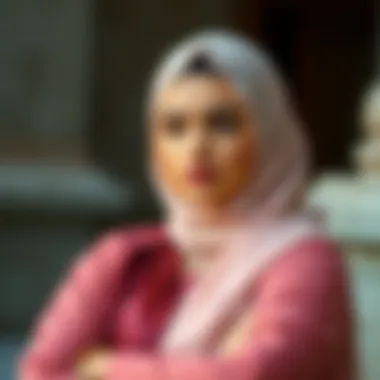

Modest Fashion Movement
Bridging Tradition and Modernity
The modest fashion movement serves as a remarkable fusion of traditional garb and contemporary style. It harmonizes the values instilled by ancient practices with the fast-paced, ever-evolving dynamics of today’s fashion world. This blending offers a voice to women who insist that tradition and modern sensibilities can coexist. A distinctive feature of this movement is its adaptability; designers often reinterpret traditional Islamic garments, infusing them with new textures, patterns, and silhouettes that appeal to a wider audience.
The advantages of this approach are twofold. Firstly, it caters to those who want to respect cultural norms while also expressing their individuality. Secondly, it attracts a growing market of consumers who appreciate authenticity and cultural richness in their clothing choices. However, some critiques exist; there’s a risk of trivializing deep-rooted beliefs when tradition is excessively commercialized. Balancing respect and innovation remains an essential challenge in this modern fashion dialogue.
Emergence of Modest Fashion Designers
With the rise of the modest fashion movement, a new generation of designers has emerged, dedicating their talents toward creating stylish and culturally resonant collections. These designers often prioritize functionality alongside aesthetics, aiming to provide clothing that accommodates wide-ranging styles while still adhering to modesty principles. A key characteristic of this new wave of fashion designers is their nuanced understanding of the cultural contexts from which they draw inspiration.
This shift is immensely beneficial for the fashion industry, as it encourages diversity and representation in an arena that has historically been dominated by Western ideals. Notably, this emergence also presents challenges; as the market grows, some designers struggle to maintain authenticity, sometimes losing touch with the cultures they seek to represent. This serves as a reminder that while commercial success is desirable, it should not come at the expense of genuine cultural narrative.
Commercialization and Challenges
Market Trends in Hijab Fashion
The market trends in hijab fashion underscore a significant transformation in how modest apparel is perceived and consumed. As global attitudes toward modesty evolve, there has been an influx of brands that cater specifically to hijab-wearing individuals. A defining characteristic of this trend is its alignment with broader societal movements toward acceptance of differing lifestyles and sartorial choices.
As such, hijab fashion has grown increasingly appealing to a younger demographic. Consumers are drawn to pieces that reflect both personal style and cultural identity, while brands find financial success in this niche market. Yet, the commercial landscape is not without complications. Some retailers may struggle to present the hijab respectfully and authentically, often leading to backlash from consumers who feel misrepresented or stereotyped. Understanding this balance is crucial for brands looking to thrive in this evolving space.
Ethical Considerations in Marketing
When discussing ethical considerations in marketing hijab fashion, it’s vital to recognize the delicate balance between promoting inclusivity and maintaining integrity in representation. Brands venturing into this market must tread cautiously, ensuring they do not exploit cultural symbols for profit. A key consideration is representation; brands should strive to include voices from the communities they aim to serve in their decision-making processes.
This ethical approach emphasizes the importance of storytelling that reflects the lived experiences of hijab wearers, rather than merely using the hijab as a marketing tool. This strategy ensures that marketing campaigns resonate deeply with the audience and cultivate trust, which is increasingly significant in a world where consumers value authenticity over superficial engagement. However, the challenge lies in achieving this balance without romanticizing or oversimplifying the complexities of individual narratives surrounding the hijab.
The intersection of culture, fashion, and ethics creates a profound dialogue that shapes the future of modest fashion, making it a compelling field for exploration.
Through examining these elements, we can uncover the dynamic relationship between the veil, hijab, and modern fashion, enabling a more profound understanding of their significance in contemporary society.
Cultural Dialogue and Representation
The concepts of cultural dialogue and representation play a vital role in our understanding of the veil and hijab. These garments are not just pieces of clothing; they signify deeper cultural meanings and narratives that deserve attention. The exploration of how these garments are depicted and discussed can lead to a broader understanding of cultural differences, allowing for a richer dialogue among communities.
Media Portrayals
Representation in Western Media
In recent years, Western media has increasingly focused on the portrayal of the veil and hijab, often with a lens that can sometimes be narrow. Common narratives tend to either sensationalize or oversimplify the experiences of Muslim women. A key characteristic of this media representation is its reliance on stereotypes, which can lead to misunderstanding. By painting a singular picture, it inadvertently overlooks the diversity among women who wear these garments.
Unique Feature: A prominent feature of Western media portrayal is the framing of hijab as a symbol of oppression, ignoring instances where women express agency and personal choice. While this perspective is often rooted in a genuine concern for women's rights, it can have harmful effects by reinforcing misconceptions that all Muslim women are oppressed.
Advantages and Disadvantages: On one hand, shedding light on the challenges faced by hijab wearers can spark meaningful conversations about women's rights. On the other hand, overemphasizing this narrative may inadvertently perpetuate stigma and lead to alienation rather than inclusivity.
"The portrayal of hijab in Western media often overlooks the variety of experiences and choices that women make around this garment."
Acknowledging Diversity of Narratives
Acknowledging the diversity of narratives surrounding the veil and hijab is crucial for a full understanding of their cultural significance. Each woman's relationship with her chosen garment is shaped by personal, social, and historical contexts, producing a wide range of stories.
Key Characteristic: This acknowledgment creates a space for multiple voices to be heard, moving beyond the binary of oppression and liberation. It celebrates individuality and allows women to share their unique experiences without fitting them into a pre-defined mold.
Unique Feature: Such recognition helps various narratives coexist, creating a tapestry of experiences that reflect real life more accurately.
Advantages and Disadvantages: While this multi-narrative approach enhances understanding, it can also lead to complexities in discussions about these garments. Sometimes, differing perspectives may clash, but ideally, they pave the way for deeper dialogue.
Social Media's Role
Influencers and Fashion Blogs
Social media has transformed the way the veil and hijab are represented and understood globally. Influencers and fashion blogs play a significant role here, offering alternative narratives that challenge traditional media portrayals. The key characteristic of influencers is their ability to humanize the garments through personal storytelling.
Unique Feature: Influencers often showcase a variety of styles and cultural backgrounds, allowing their audiences to see the hijab in a new light. This platform fosters creativity, encouraging various interpretations of modest fashion, which are generally missing from mainstream outlets.
Advantages and Disadvantages: The rise of these platforms can normalize the hijab as a fashionable choice rather than a symbol of oppression. However, the commercial aspect sometimes overshadows authentic representations, leading to superficial views of an issue that is rich in cultural significance.
Participation in Global Conversations
The participation of women in global conversations via social media allows for a more nuanced exchange of ideas surrounding the veil and hijab. This collaborative aspect of social media fosters a sense of community among individuals from different backgrounds, igniting discussions on cultural identity and self-expression.
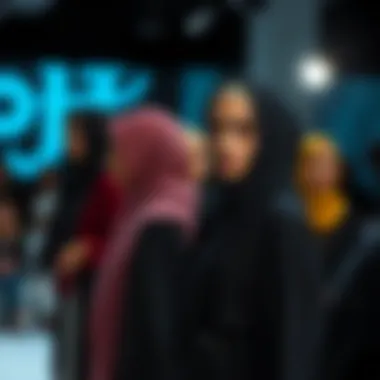

Key Characteristic: This involvement promotes awareness of the challenges hijab wearers might face, planting seeds for advocacy and supporting movements that monitor women’s rights.
Unique Feature: Women can share their stories, creating solidarity and empathy within a larger global context.
Advantages and Disadvantages: While this dialogue can promote understanding, it sometimes leads to polarized perspectives, with different factions clashing over the meanings of the veil or hijab. Nonetheless, these exchanges are invaluable in building a richer, more inclusive cultural narrative.
Personal Narratives
Personal narratives serve as a vital thread in the broader tapestry of understanding the cultural and fashion dynamics of the veil and hijab. They reflect lived experiences and individual choices, offering glimpses into the diverse perspectives surrounding these garments. By delving into personal stories, we can better appreciate how the veil and hijab are often more than mere articles of clothing—they are intertwined with identity, faith, and culture. Such narratives provide an invaluable resource for exploring the intersectionality of personal choice within the frameworks of societal expectations and cultural traditions.
Women’s Experiences
Journey to Embrace the Hijab
The journey to embrace the hijab is often a profound aspect of many women's lives. This journey can be marked by a multitude of feelings, beliefs, and influences. Some women have described it as a pathway to self-empowerment and spiritual connection. The decision to wear the hijab frequently stems from a desire for modesty, but it often evolves into a personal symbol of faith. It's not uncommon for women to attribute their choice to the teachings of family or community, highlighting the cultural significance intertwined with their individual decisions.
Among the critical characteristics of this journey is the internal conflict that many experience. On one hand, the hijab can represent a sense of belonging and an affirmation of one's identity. On the other hand, women may face external pressures or discrimination, particularly in societies where hijab-wearing is less understood or accepted. This duality makes the journey not just about clothing, but about navigating societal expectations while asserting personal beliefs.
Furthermore, embracing the hijab often comes with unique features that vary widely among individuals. For some, it might include experimenting with styles or accessorizing, thus infusing a personal touch into their outward appearance. This ability to mix tradition with personal flair can be empowering, as it aligns with the fashion dynamics discussed throughout the article. However, challenges exist too—some women recount their struggles with societal perceptions or the complexity of balancing personal beliefs with cultural expectations.
Personal Stories of Resistance
Personal stories of resistance illuminate another compelling aspect of the veil and hijab narrative. These stories often arise from individuals standing firm against societal norms or challenges, advocating for their right to express their identity through their attire. For many, wearing the hijab becomes a declaration of autonomy; a refusal to conform to dominant cultural narratives that may oppose one’s beliefs or practices.
The key characteristic of these resistance stories is their empowerment. They highlight the resilience of women who challenge misconceptions about the hijab, thereby fostering broader societal understanding and acceptance. These narratives often serve as testaments to courage, as many women undertake the journey of defiance against stereotypes or prejudices they face when adorning the hijab.
A unique feature of these personal stories is their capacity to inspire others. Sharing experiences of defiance and resilience can create a ripple effect, encouraging and supporting women who might feel isolated in their choices. Yet, there can be disadvantages; narratives of resistance might attract scrutiny or backlash, as societal attitudes toward the hijab can be polarizing. Despite these challenges, the act of sharing such stories contributes to a growing movement towards intersectional feminism, empowering women from diverse backgrounds.
Inter-generational Perspectives
Influence of Family and Tradition
The influence of family and tradition plays a crucial role in shaping individuals' views on the veil and hijab. For many women, these perspectives are often passed down through generations, infusing the act of wearing the hijab with historical significance and familial pride. This connection to heritage can be empowering, reinforcing a woman's identity within her cultural framework.
One of the notable characteristics of this influence lies in the shared narratives within families. Daughters may learn about the hijab not as an imposition, but rather as a deeply rooted tradition that reflects collective identity and values. The cultural transmission of these practices serves to strengthen community bonds while also encouraging personal interpretations of modesty and style.
However, it's worth noting that these influences may not always align seamlessly with contemporary views. Some individuals may find themselves in conflict with their family's beliefs as societal norms evolve. This dissonance presents both challenges and opportunities for dialogue, as younger generations navigate their identities while honoring family traditions.
Changing Attitudes Over Generations
Changing attitudes over generations highlight the evolution of perspectives regarding the veil and hijab. As societal norms shift and new dialogues emerge around feminism and individual expression, the interpretation of these garments continues to transform. Younger generations develop their perceptions, influenced by modern contexts but often rooted in traditional values.
A key characteristic of these changing attitudes is the increased emphasis on personal choice and agency. While previous generations might have viewed the hijab strictly through religious or cultural lenses, contemporary discussions often encompass a wider array of perspectives, including feminist interpretations of modesty and autonomy. The resulting narratives showcase how young women articulate their rights to choose whether or not to wear the hijab, often reclaiming the narrative from those who attempt to dictate its meaning.
This evolution allows for enriched conversations about identity and representation, though it can lead to divisions within families or communities. Generational gaps can spark heated debates, but they can also serve as fertile ground for progressive ideas. By tracing these changing attitudes, one can appreciate the broader societal conversations about the veil and hijab, which continue to redefine cultural dynamics.
"Personal narratives create a lens through which we can examine the complexities of identity, faith, and resistance, emphasizing the necessity of individual stories in the discourse surrounding the veil and hijab."
Through these explorations, readers gain insight into how personal narratives shape and are shaped by cultural and societal factors, reminding us that every story matters in understanding the rich interface of fashion and identity.
The End and Future Outlook
The journey through the intricate relationship between the veil and hijab unveils a rich tapestry of culture, identity, and fashion. Understanding the dynamics at play in these garments not only informs us about their historical significance but also the evolving narratives that surround them today. The veil and hijab represent much more than fabric; they embody personal choice, cultural pride, and steadfast individuality amidst a globalizing world.
As fashion trends continue to shift, the spotlight on modest attire evolves too. Innovative designs and approaches challenge the notion that modesty equates to a lack of style. We’re witnessing a surge of creative minds in the modest fashion sector, with brands like Haute Hijab and Aab creating pieces that are both appealing and respectful of the wearer’s values. Shoppers today seek more than just aesthetic appeal—they desire authenticity and representation.
Moreover, the conversation about inclusivity must be at the forefront of fashion discussions moving forward. As barriers between diverse cultures diminish, it is pertinent that brands recognize and celebrate the nuanced identities of individuals who wear the hijab and veil. This recognition fosters a more equitable fashion landscape, paving the way for designs that resonate with a myriad of cultural backgrounds.
Emerging Trends in Veiling and Hijab Fashion
The exploration of emerging trends in veiling and hijab fashion indicates a remarkable transformation in how these garments are perceived and presented. Recent trends reflect a fusion of contemporary styles with traditional roots. Here are some notable shifts worth noticing:
- Sustainability: More brands are focusing on eco-friendly materials and ethical labor practices, responding to the growing demand for sustainable fashion.
- Streetwear Influence: The fusion of modest fashion with streetwear aesthetics has resulted in garments that blend comfort and chic effortlessly.
- Digital Presence: E-commerce platforms and social media influencers are playing a pivotal role in reshaping modest fashion, making these styles accessible to a global audience. The hashtag #modestfashion is a testament to the growing community around these discussions.
- Customization: Tailoring options are becoming more prevalent, allowing individuals to express their unique styles, while still adhering to personal and cultural preferences.
This trend toward personalization allows wearers to engage with their cultural heritage while making individual style statements.
Call for Inclusivity in Fashion Discourses
A pressing call for inclusivity in fashion conversations highlights the rich diversity within the communities that embrace the veil and hijab. The time has come for brands and designers to look beyond blanket representations and recognize the vast array of cultural narratives intertwining with modesty.
- Education and Awareness: Fashion professionals should engage in continuous learning about the varied meanings of veiling practices across different cultures.
- Collaborative Projects: Brands can benefit immensely from collaborations with hijab-wearing designers and influencers, creating authentic collections that resonate with the intended audience.
- Community Engagement: Initiatives that include workshops, panels, or forums offer spaces for discussion and co-creation while fostering understanding among fashion enthusiasts and industry insiders alike.
By embracing and amplifying diverse voices in fashion discourses, not only do we enrich the industry as a whole, but we also create a more welcoming environment for all individuals eager to express their identities. The future outlook for the veil and hijab in fashion is bright; it is a landscape where tradition meets innovation, and respect fosters creativity.
"Inclusion is never a compromise, but rather the best pathway toward sustainable fashion."
As this complex engagement with modest fashion continues to evolve, one fact remains clear: the veil and hijab are here to stay, actively shaping the global fashion narrative. The onus is on industry leaders and consumers alike to ensure these discussions remain inclusive, diverse, and reflective of the beautiful tapestry of human culture.







